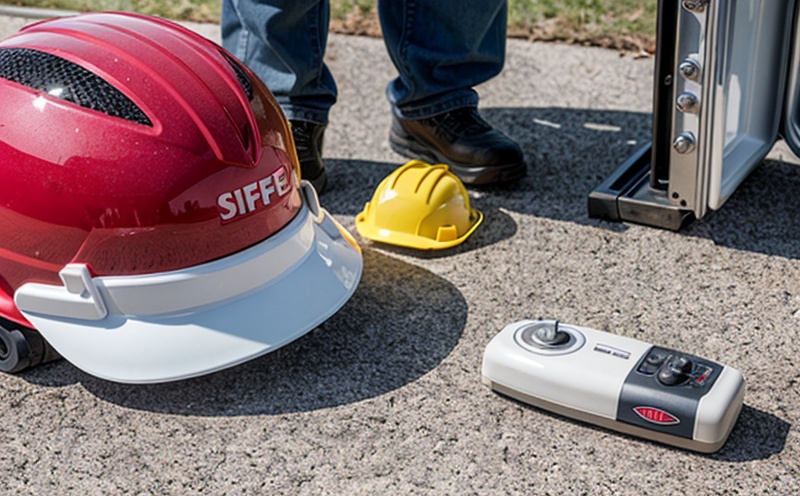ISO 18820 Lifeboat Buoyancy and Self-Righting Testing
The ISO 18820 standard is a critical guide for testing lifeboat buoyancy and self-righting capabilities. This service ensures that lifeboats meet the stringent requirements of maritime safety regulations, providing peace of mind to ship operators and passengers alike. The test evaluates whether lifeboats can maintain sufficient buoyancy when exposed to various water conditions, ensuring they can keep afloat long enough for rescue.
The testing procedure involves placing the lifeboat in simulated environments that mimic real-world scenarios. These include tests conducted under different water depths, temperatures, and wind speeds. The goal is to determine if the lifeboat will float and remain stable when subjected to these conditions. Self-righting tests are also conducted to ensure that the boat can return to its upright position after capsizing.
Lifeboats must pass rigorous buoyancy and self-righting tests before being certified for use on vessels. The test setup includes a series of steps designed to simulate actual maritime conditions, including immersion in water and exposure to different angles of inclination. This process ensures that lifeboats are not only buoyant but also capable of righting themselves if they capsize.
Lifeboat manufacturers must adhere to the ISO 18820 standard as part of their compliance with international safety regulations. By conducting these tests, operators can verify that their lifeboats meet all necessary requirements and can be trusted in emergency situations. The test results are crucial for maintaining the integrity of the equipment and ensuring maritime safety.
The testing process begins with thorough preparation of the specimen, which involves cleaning and drying the lifeboat to ensure accurate measurements. The boat is then placed into a controlled environment where it undergoes various tests designed to evaluate its buoyancy and self-righting capabilities. During these tests, precise instrumentation measures key parameters such as water displacement, stability angles, and recovery time.
Once the testing is complete, detailed reports are generated that document all aspects of the test procedure and results. These reports provide comprehensive insights into the lifeboat's performance under different conditions, helping operators make informed decisions about maintenance and replacement schedules.
Why It Matters
The importance of ISO 18820 testing cannot be overstated in the maritime industry. Lifeboats are critical safety devices that must perform flawlessly in emergency situations, which is why they undergo rigorous testing to ensure their reliability and effectiveness. By adhering to this standard, operators can rest assured knowing that their lifeboats meet the highest safety standards.
The tests conducted under ISO 18820 not only evaluate the buoyancy of lifeboats but also assess their self-righting capabilities. This dual assessment ensures that in case of a capsizing incident, the boat can quickly return to its upright position and remain stable until rescue arrives. The self-righting test is particularly important as it simulates real-world scenarios where the boat might capsize due to high winds or rough seas.
Compliance with ISO 18820 is mandatory for lifeboats used on vessels operating in international waters. This standard ensures that all lifeboats meet the same rigorous safety criteria, reducing the risk of accidents and improving overall maritime safety. By following this standard, operators can ensure their equipment meets regulatory requirements and provides maximum protection to passengers.
The results of these tests are crucial for maintaining the integrity of the equipment and ensuring maritime safety. In the event of an emergency, lifeboats must be relied upon to provide immediate assistance. Therefore, it is essential that they pass all necessary tests and meet the required standards. By adhering to ISO 18820 testing protocols, operators can ensure their lifeboats are prepared for any situation.
In conclusion, the importance of ISO 18820 testing cannot be overstated in the maritime industry. This standard ensures that all lifeboats meet the highest safety standards, providing peace of mind to ship operators and passengers alike. By adhering to this standard, operators can ensure their equipment is reliable and effective in emergency situations.
Scope and Methodology
The scope of ISO 18820 testing includes evaluating the buoyancy and self-righting capabilities of lifeboats. The test setup involves placing the lifeboat into a controlled environment where it undergoes various tests designed to simulate real-world conditions. These tests include immersion in water, exposure to different angles of inclination, and capsizing scenarios.
The methodology for these tests is based on international standards such as ISO 18820:2020. The test procedure begins with thorough preparation of the specimen, which involves cleaning and drying the lifeboat to ensure accurate measurements. The boat is then placed into a controlled environment where it undergoes various tests designed to evaluate its buoyancy and self-righting capabilities.
During these tests, precise instrumentation measures key parameters such as water displacement, stability angles, and recovery time. The test setup includes a series of steps designed to simulate actual maritime conditions, ensuring that the lifeboat can maintain sufficient buoyancy and return to its upright position after capsizing. Once the testing is complete, detailed reports are generated that document all aspects of the test procedure and results.
The scope of ISO 18820 testing ensures that lifeboats meet the highest safety standards, providing peace of mind to ship operators and passengers alike. By adhering to this standard, operators can ensure their equipment is reliable and effective in emergency situations. The methodology for these tests is based on international standards such as ISO 18820:2020.
Industry Applications
- Marine Safety Regulation Compliance: Ensures that lifeboats meet the strictest regulatory requirements for maritime safety, thereby enhancing overall vessel compliance with international standards.
- Enhanced Operational Efficiency: Provides operators with detailed reports on the performance of their lifeboats under various conditions, allowing for informed decision-making regarding maintenance and replacement schedules.
The results of these tests are crucial for maintaining the integrity of the equipment and ensuring maritime safety. In the event of an emergency, lifeboats must be relied upon to provide immediate assistance. Therefore, it is essential that they pass all necessary tests and meet the required standards.





